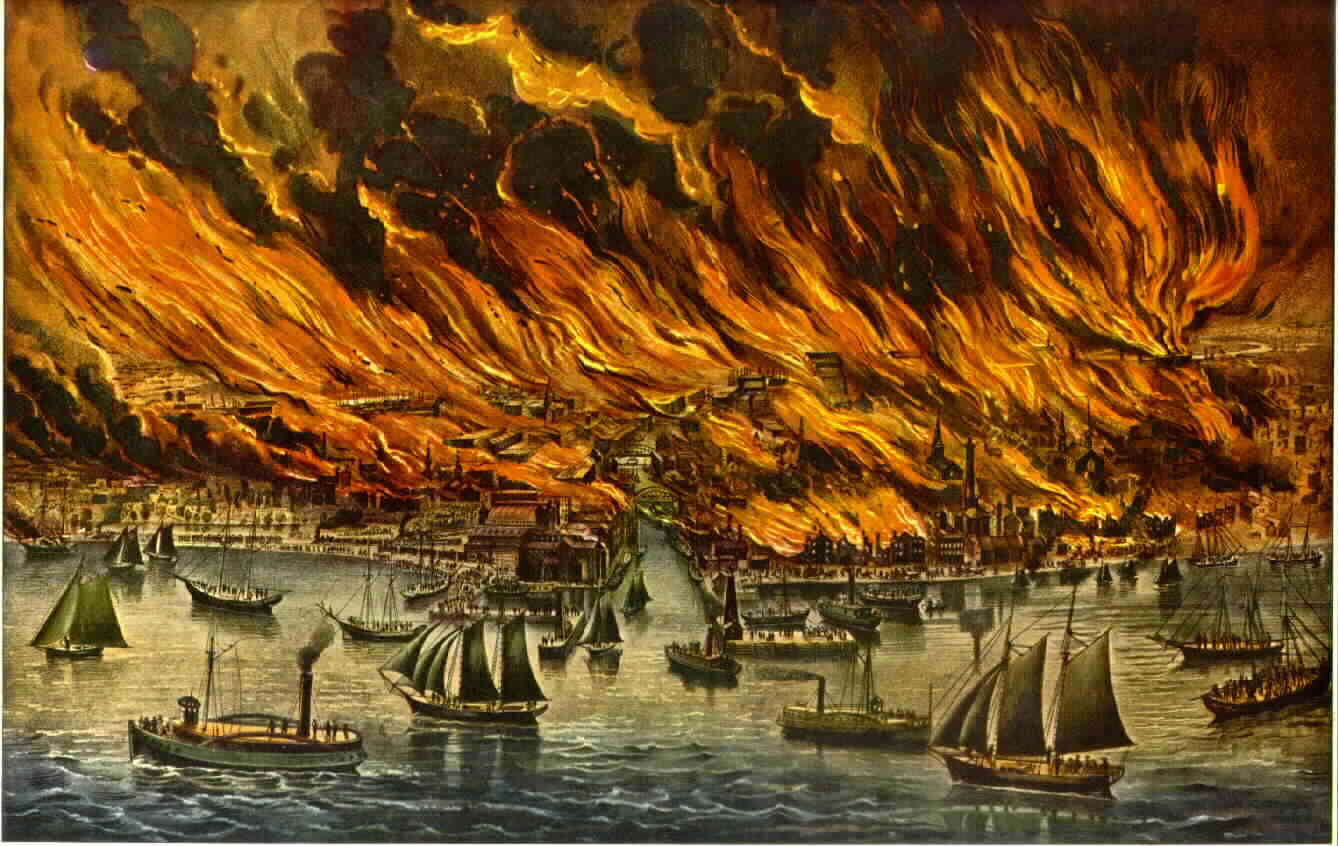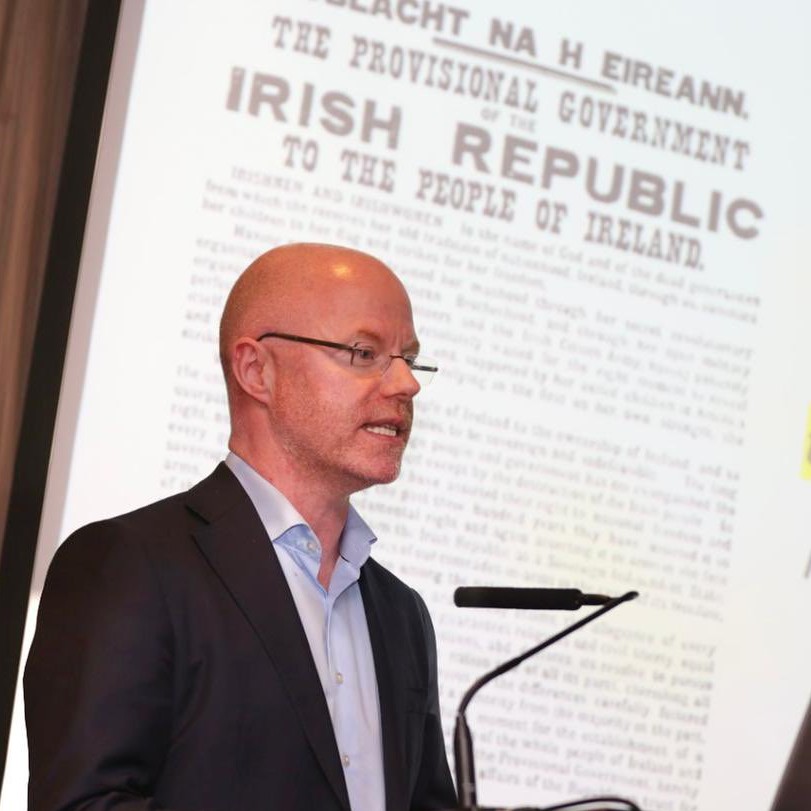The Great Chicago Fire 1871

The Great Chicago Fire burned ferociously through the city from October 8th to October 10th, 1871, destroyed thousands of buildings, killing an estimated 300 people. The damage caused by the inferno at the time cost an estimated $200 million in damages. The Legend goes that the fire was caused by a cow kicking over a lantern in a barn, however other theories surrounding the blaze have laid the blame at arsonists or the possibility that even a meteor might have been responsible for the event that left an area of about four miles long and almost a mile wide of the Windy City, including its business district, in complete ruins. Following the blaze, reconstruction efforts began quickly and spurred great economic development and population growth.
Whatever actually started the fire, there is little dispute of where it started. It had been subsequently proven that on the Sunday evening of October 8, 1871, something ignited a fire inside the barn of Patrick and Catherine O’Leary at 137 De Koven St. on Chicago’s west side.
After the flames had finally subsided on Tuesday morning, the Great Fire had consumed more than three square miles (some 2,000 acres) of the city, taken 300 lives and left 100,000 without homes, which was around a third of the city’s population. Believe it or not and the O’Leary’s house was located upwind of the fire and survived totally undamaged.
In the aftermath of the fire 51 people who were near the fire when it broke out along with experts brought in to examine the scene came to the conclusion that it was unable to identify the cause. This resulted in a host of other theories being speculated in the wider community.
Apparently there were some inconsistencies in the testimonies of Daniel “Peg Leg” Sullivan and Dennis Regan. Sullivan’s house was located across the road and to the east of the O’Leary’s. He testified that, after visiting the O’Leary’s, he walked across the road, proceeded past his own house, then sat in front of William White’s house, one door up.
Sullivan said he could see the fire break out later and ran to the O’Leary’s to help save the animals. This didn’t quite add up for the authorities due to the fact that the view from William White’s house to the O’Leary barn was blocked by the James Dalton house.
Regan testified that he heard music as he passed the McLaughlin house, where a party had been going on, on his way to help with the fire. This also didn’t match up with other testimony given by Mrs. McLaughlin who said that the fire had started after the music stopped.
Locals had suggested a theory that the two men were in the barn, where they had been hundreds of times and began to argue. In the midst of a fight the perhaps accidentally knocked Mr. Sullivan’s pipe from his hand leaving it on the ground leading to the fire to start.
Another theory surrounding the cause of the fire is that it may have been ignited by a fragment of a rogue comet that touched off upstate Wisconsin and Michigan on the same night. Scientists have speculated that fragments from Biela’s Comet could have ignited the Great Fire in Chicago but it has often been rejected.
Chicago at the time was a place where the manufacturing East met the agricultural West of the U.S. This was also a time when the nation was beginning to flex its financial muscles on the international stage.
There was an ever-increasing influx of people, money, goods, and information. There was the lakefront and the branches of the Chicago River, which split the city into north, south, and west; each sector buzzed with commercial activity. Ten railroads converged on Chicago. The city was linked by rail coast to coast. Seventeen grain elevators had a total capacity of about 12 million bushels.
The city had averaged about two fires a day during the previous year, including 20 in the previous week. The largest of those had occurred on the Saturday night, on the eve of the “Great Fire.”
After the fire began at the O’Leary’s it surged straight to the centre of town, aided by gusting winds. The blaze then unexpectedly jumped the South Branch of the Chicago River around midnight. Splitting in two yet again, the fire consumed Conley’s Patch, a shantytown of Irish immigrants. These were tightly packed wooden structures that offered no resistance to the blaze. By 1:30 the raging fire had made its way to the city’s courthouse tower. City officials released the prisoners moments before the great bell came crashing through the ceiling of the basement of the building.
In the south side of the city, the offices of the Chicago Tribune, whose editors throughout the summer had railed against lax fire safety standards, were completely destroyed. The fire was now so massive and widespread that even the ground was on fire. The streets and bridges were all made of wood which provided sufficient fuel for the inferno. The river was also vulnerable, as several vessels on the water and grease that had been dumped along the banks of the river also ignited.
The runaway inferno was now showing signs of what fire-fighters call a “convection effect.” This is where a fire has the ability produce a concentrated updraft allowing it to move forward on its own accord without help from any wind. Air from all directions was getting sucked into the centre of the flame. This generated a whirlwind effect that carried flaming debris high into the sky.
The flaming debris landed onto the city waterworks, destroying the structure and effectively shutting down any firefighting efforts. As the fire marched relentlessly north, another phenomenon known as spontaneous combustion, resulted in buildings bursting into flames without coming into contact with the main body of the fire.
In the North Division of the city, tens of thousands of ethnic Scandinavians and Germans had more time to escape than those in Conley’s Patch, yet nearly all suffered the same fate — the loss of whatever dwelling in which they had resided. Miraculously, only the mansion of real estate millionaire Mahlon D. Ogden was spared from the flames, saved by a shift in the wind.
Eventually the fire reached the edge of the city with only prairie grass and dry sod to feed the flames, and expired on its own. The burned-out, bedraggled, and newly homeless flocked together in disoriented groups on open stretches of prairie west and northwest of town; in the South Division, refugees huddled along Lake Michigan, in the North Division, they hunkered down at the south end of Lincoln Park and along “the Sands,” a scrap of lakeshore just north of the river.
People who previously had little reason to speak to each other were shepherded together in one group. As one historian put it, “One could find Mr. McCormick, the millionaire of the reaper trade, and other north-side nabobs, herding promiscuously with the humblest labourer, the lowest vagabond, and the meanest harlot.”
The aptly called “Burnt District,” a map of which appeared in virtually every printed account of the fire, comprised an area four miles long and an average of three-quarters of a mile wide — more than two thousand acres — including more than 28 miles of streets, 120 miles of footpaths, and at least 2,000 lamp posts.
Gone, too, were countless trees, shrubs, and flowering plants in “the Garden City of the West.” Approximately 18,000 buildings and about a third of the valuation of the entire city went up in flames. Even though half of that amount was insured, several company failures cut the actual payments in half.
Those structures and businesses left standing were located on the west or south sides of the Burnt District. They included most of the heavy industries, including the stockyards. The downtown railroad depots were totaled, but not the far more critical rail lines themselves. What the fire could not touch was one of Chicago’s most important assets, its location. It made the city more accessible to resources and markets throughout the nation and the world at a time when the United States was assuming a role in world leadership in industrial enterprise.
Because of Chicago’s pre-fire economic momentum and commercial ties and the unique geographic situation, the city was in a good condition to be able to rebuild. One thing the Great Fire hadn’t taken from the people of Chicago was their grit and determination to rebound from the tragedy. The city would in time become bigger, better and ultimately wiser.
The great fire had brought the best out of the citizens of Chicago.. Joseph Medill, publisher of the Chicago Tribune, put out a special edition trumpeting, “Chicago will rise from the ashes!” Potter Palmer, whose new hotel and 32 other holdings were destroyed in the fire, set out immediately to raise capital for reconstruction. Jonathan Scammon broke ground on a new, fully pre-rented office building only four days after the fire. The confidence and enthusiasm of those men and others rang up and down the social ladder, calling Chicagoans to the challenge.
City officials, in makeshift offices in the First Congressional Church on the city’s west side, set the price on bread, forbade wagon drivers from charging more than what was normal, and limited saloon hours, in order to keep looting and price-gouging to a minimum. They also banned smoking.Even before the fire burnt itself out, plans were being made to remake the city. Within days, even as the rubble was being removed, enterprising small businesses erected sheds and stands.
Business traffic began to move again. Within six weeks, more than 200 stone and brick buildings had been started in the South Division alone.By 1872, $50 million had been pumped into construction. In 1873, amid a national recession, Chicago proudly hosted the Inter-State Industrial Exposition, which promoted the city and the Northwest (of that era). By 1885, America had its first skyscraper, the nine-story high Home Insurance Building. Over the next two decades, hundreds of millions of dollars would pour into Chicago. By the end of the 19th century, the city was well on its way to recovery.
You might also like
For relevant updates on Emergency Services news and events, subscribe to EmergencyServices.ie









